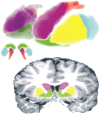Dopamine release in dissociable striatal subregions predicts the different effects of oral methylphenidate on reversal learning and spatial working memory
- PMID: 19369539
- PMCID: PMC6665353
- DOI: 10.1523/JNEUROSCI.3266-08.2009
Dopamine release in dissociable striatal subregions predicts the different effects of oral methylphenidate on reversal learning and spatial working memory
Abstract
Previous data suggest that methylphenidate can have variable effects on different cognitive tasks both within and between individuals. This is thought to be underpinned by inverted U-shaped relationships between cognitive performance and dopaminergic activity in relatively separate fronto-striatal circuits and reflected by individual differences in trait impulsivity. Direct evidence for this is currently lacking. In this study, we demonstrate for the first time that therapeutic doses of oral methylphenidate administered to young healthy subjects result in different sized changes in D(2)/D(3) receptor availability in different regions of the human striatum and that the change in receptor availability within an individual subregion predicts cognitive performance on a particular task. Methylphenidate produced significantly different effects on reversal learning and spatial working memory tasks within individuals. Performance on the reversal learning task was predicted by the drug-induced change in D(2)/D(3) receptor availability in postcommissural caudate, measured using [(11)C]-raclopride radioligand PET imaging, whereas performance on the spatial working memory task was predicted by changes in receptor availability in the ventral striatum. Reversal learning performance was also predicted by subjects' trait impulsivity, such that the most impulsive individuals benefited more from methylphenidate, consistent with this drug's beneficial effects on cognition in attention deficit hyperactivity disorder.
Figures




References
-
- Arnsten AF, Goldman-Rakic PS. Noise stress impairs prefrontal cortical cognitive function in monkeys: evidence for a hyperdopaminergic mechanism. Arch Gen Psychiatry. 1998;55:362–368. - PubMed
-
- Aron AR, Dowson JH, Sahakian BJ, Robbins TW. Methylphenidate improves response inhibition in adults with attention-deficit/hyperactivity disorder. Biol Psychiatry. 2003;54:1465–1468. - PubMed
-
- Bedard AC, Ickowicz A, Logan GD, Hogg-Johnson S, Schachar R, Tannock R. Selective inhibition in children with attention-deficit hyperactivity disorder off and on stimulant medication. J Abnorm Child Psychol. 2003;31:315–327. - PubMed
-
- Brett M, Johnsrude IS, Owen AM. The problem of functional localization in the human brain. Nat Rev. 2002;3:243–249. - PubMed
-
- Chudasama Y, Robbins TW. Psychopharmacological approaches to modulating attention in the five-choice serial reaction time task: implications for schizophrenia. Psychopharmacology (Berl) 2004;174:86–98. - PubMed
Publication types
MeSH terms
Substances
Grants and funding
LinkOut - more resources
Full Text Sources
Medical
